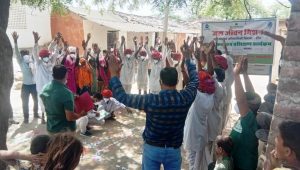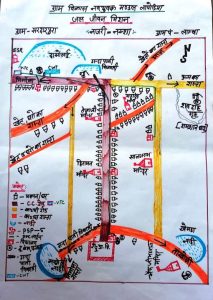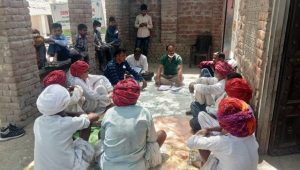 Government of India has restructured and merged all existing drinking water projects under National Rural Drinking Water Program(NRDWP) and New Project Jal Jeevan Mission (JJM) started in 2020 to provide Functional Household Tap Connection (FHTC) to every rural household i.e., Har Ghar Nal Se Jal (HGNSJ) by 2024. The following kinds of works/ schemes are proposed to be taken up under JJM:
Government of India has restructured and merged all existing drinking water projects under National Rural Drinking Water Program(NRDWP) and New Project Jal Jeevan Mission (JJM) started in 2020 to provide Functional Household Tap Connection (FHTC) to every rural household i.e., Har Ghar Nal Se Jal (HGNSJ) by 2024. The following kinds of works/ schemes are proposed to be taken up under JJM:
i.) In-village water supply (PWS) infrastructure for tap water connection to every household;
ii.) Reliable drinking water source development/ augmentation of existing sources;
iii.) Transfer of water (multi-village scheme; where quantity & quality issues are there in the local water sources);
iv.) Technological intervention for treatment to make water potable (where water quality is an issue, but quantity is sufficient);
v.) Retrofitting of completed and ongoing piped water supply schemes to provide FHTC and raise the service level;
vi.) Grey water management;
vii.) Capacity building of various stakeholders and support activities to facilitate the implementation.
 Service level delivery under JJM:
Service level delivery under JJM:
- The goal of JJM is to provide functional household tap connection to every household with service level at the rate of 55 liters per capita per day (lpcd).
- The institutional mechanism under JJM:
- National level National Jal Jeevan Mission
- State level State Water and Sanitation Mission (SWSM)
- District level District Water and Sanitation Mission (DWSM)
- Gram Panchayat level Paani Samiti/ Village Water & Sanitation Committee (VWSC)/ User group
Financial Implication and Funding Pattern under JJM: Total estimated cost of JJM is Rs. 3.60 Lakh Crore. The fund sharing pattern between Centre and State is 90:10 for Himalayan (Uttarakhand, Himachal Pradesh) and North-Eastern States, 100:0 for UTs and 50:50 for rest of the States.
GVNML Partnered with Govt. of Rajasthan for Tonk district to implement JJM as ISA (Implementing Support Agency)
The role of GVNML is as follows:
GVNML will have to work in each phase of the scheme cycle. ISA will play critical role as partners in mobilizing and engaging the communities to plan, design, implement, manage, operate & maintain in-village water supply infrastructure. Based on the District Action Plan of five years, the number of villages to be covered every year will be identified. These identified villages fall under different categories, viz. villages requiring only last-mile connectivity in terms of distribution network and FHTCs, only IEC campaigns on judicious water use, O & M support, requiring new schemes, etc. and will be implemented by ISA GVNML and facilitate the implementation process with group formed as VWHSC, Pani Panchayat etc. and extend handholding support for 100% FHTC in whole district. Planning should be done in such a manner that JJM is implemented in mission mode and all villages of districts are covered with FHTCs to all rural households by 2024.
 ISAs will primarily carry out the following functions:
ISAs will primarily carry out the following functions:
- Facilitate constitution of sub-committee of Gram Panchayat, i.e. VWSC etc. and arrange to build capacities of its functionaries;
- Use Participatory Rural Appraisal (PRA) tools for community mobilization and carry out need assessment;
- Assist in preparation of Village Action Plan (VAP)
- Handhold Gram Panchayat and/ or its subcommittee, i.e. VWSC etc. in all the functions mandated inter alia includes opening bank accounts, mobilization of community contribution, O&M arrangement, organizing Gram Sabha, organizing meetings of sub-committee, facilitating resolution in Gram Sabha and acceptance of village scheme, facilitating sanitation and grey water management activities, etc.;
- Need assessment of FHTCs and motivate communities to have FHTCs;
- Act as coordination platform between DWSM and VWSC;
- Assisting the community in water campaigns initiated by Government of India/ state Government;
- Build awareness on various aspects of water such as rain water harvesting, artificial recharge, water quality, water-borne disease, water saving, water handling, drinking water source augmentation/ sustainability aspects, etc.;
- Document and upload success stories from villages;
- Ensure wall-paintings are done at the proper places in villages;
- Carry out social & behavioral change Communication (SBCC) activities.
- Engage in all activities as per the scheme cycle
- Conduct baseline survey as and when required
- Take up IEC activities at the GP/Village level
- Capacity building of PRIs
- Conduct/coordinate training program for GPWSC/VWSC etc
As of June 2021 around 80 villages covered by different JJM activities like PRA, baseline survey, meeting with VWHSC, Bank account opening, preparation of VAP etc.